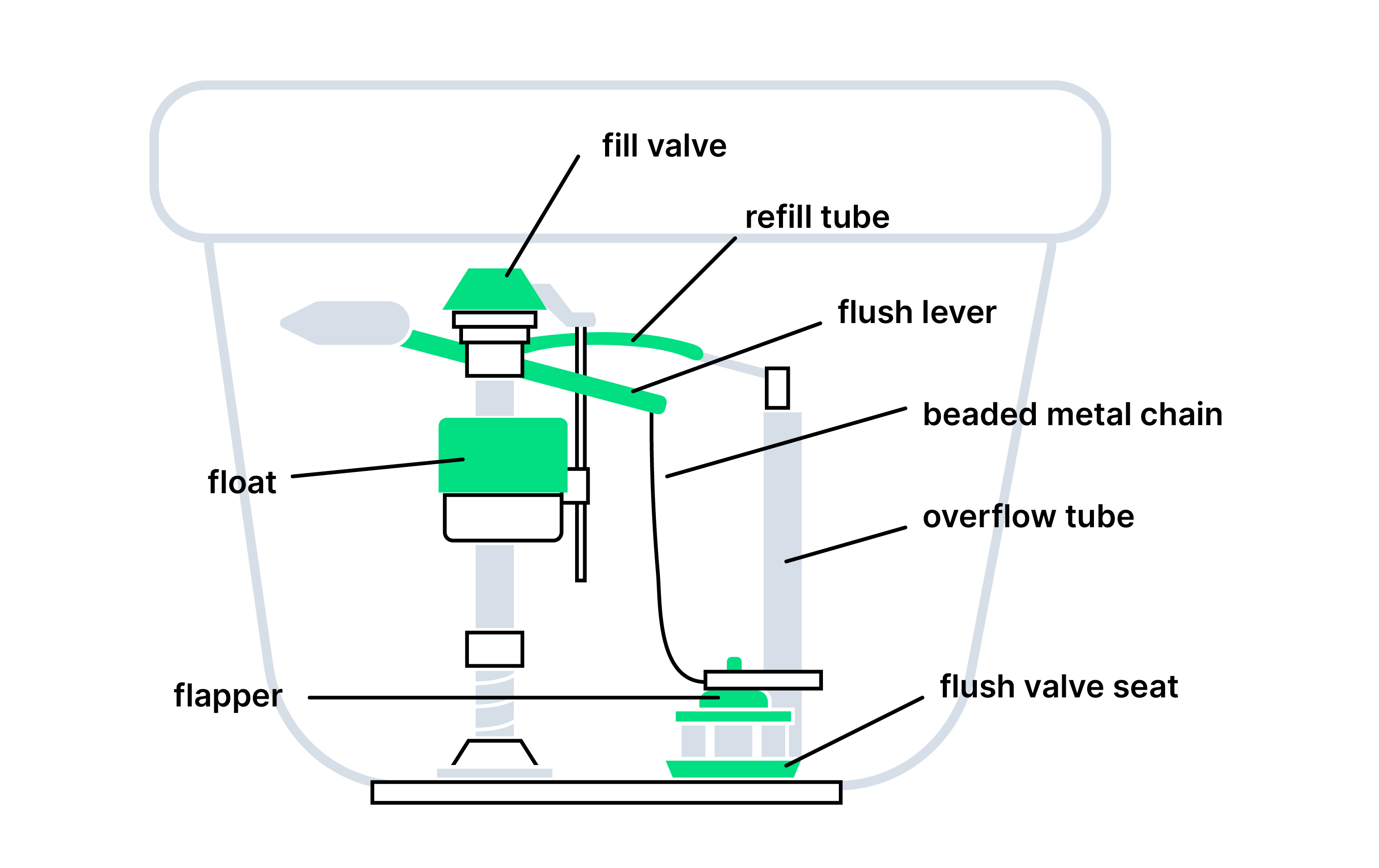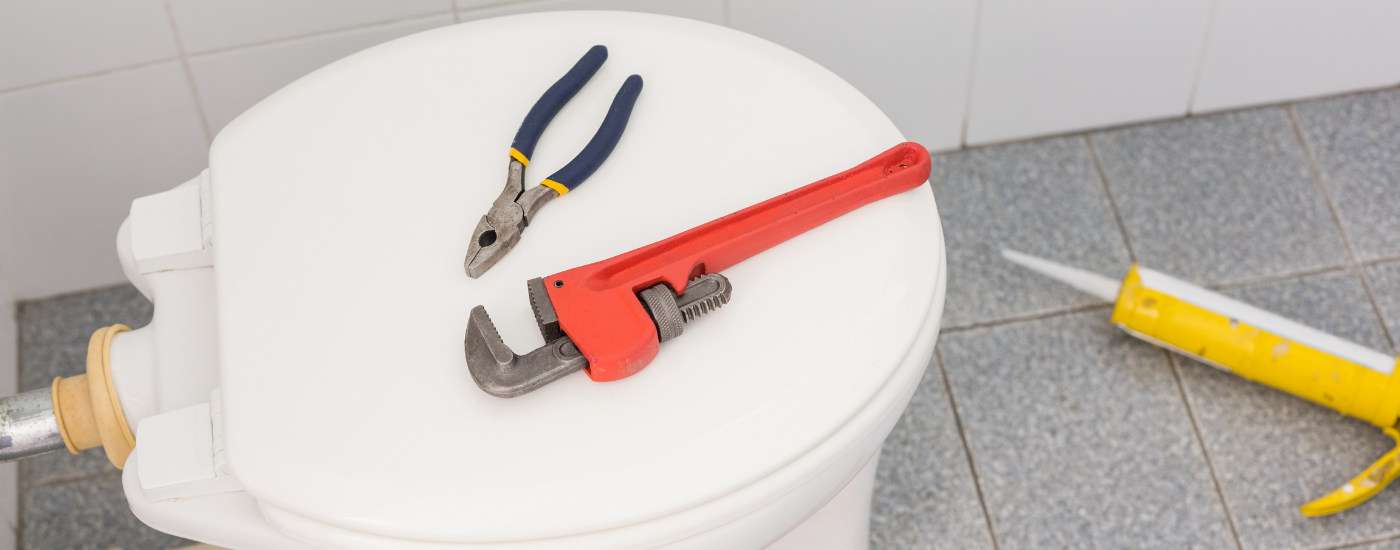Performing household repairs yourself not only provides you with self-satisfaction but assures you that the job was done right and can save you money. And if there’s one room we depend on the most, it’s the bathroom—the toilet more specifically. While fixtures in the “throne room” may occasionally require some attention, the good news is most common toilet repairs can be DIY, necessitating few (if any) simple tools. Keep reading for some general knowledge on toilet components, some do’s and dont’s of repair, and how to fix some of the most common issues.
How a Toilet Works
The two main parts that make up your toilet are its tank and the bowl. The toilet bowl is where you can find the seat and this portion of your toilet contains water and is connected to the drain so that it can dispose of wastewater and waste. The tank (pictured below) sits above and behind the bowl. This portion of your toilet contains the water used to refill the bowl after flushing, plus the equipment your toilet needs in order to flush clean water into the bowl and to refill the tank.

The fill valve, at the top of the tank, is connected to the water supply and controls the delivery of water to the tank. When you initiate a flush, the tank’s water swiftly drops down into the bowl and that pressure causes the wastewater from the bowl to go down the drain. The float senses this water level decrease and triggers the fill valve to refill the tank. Presto! That’s how a toilet works.
Do’s and Dont’s of repair
- DON'T go in unprepared. When it comes to any DIY home renovation or repairs, do your homework to inform yourself of the entire process before you start any project
- DO grab your tool belt or toolbox. Having the necessary equipment on hand before you get started will eliminate trips looking for supplies or the right tool. You’ll also have a better understanding of precisely how to get the job done. This step goes hand-in-hand with preparation. Research ahead of time what tools and supplies you will need to complete your project with ease
- DO document the plumbing setup you plan to work on before you start. This can be as simple as photographing/videoing the area from different angles so that you're not faced with that worrisome feeling when you begin to reassemble and can’t quite recall how it should be done. In fact, this is great advice for any home repair project
- DON'T attempt a plumbing fix in the evening or on a Sunday/holiday. If things go wrong, your local hardware store may not be open, or you may have to pay the high price of an emergency visit from your local plumber
- DON'T use chemical cleaning products to clear our drains. The truth is, using chemical products can damage your pipes through corrosion
- DO call Hippo Home Care before you attempt any DIY home repair, especially when it comes to your toilet/plumbing. Not only can our experts help troubleshoot, but they can also recommend professionals in the area if they think the issue is more significant than a DIY fix
Most common fixes
Running Toilet
Is your toilet running? Well, you better catch it. All jokes aside, a running toilet is costing you more than you think. In terms of cost, it’s similar to leaving a faucet running non-stop. Not only is water costly, but it is also a precious commodity that shouldn’t be wasted.
Fixing your running toilet is easier than you may think This all too common problem that occurs because either the flapper isn't fitting snugly in the flush valve opening or your toilet may be running because there is too much water in your toilet’s tank. Once the water has gone over the level of the tube, as a safety measure, the water will begin to run down into the tank so that the tank doesn't flood. Repairs for either of these issues are easily made. Refill valves have lots of methods for easy adjustment so that you get the perfect level of water in the tank, and flapper valves are a snap to modify or replace.
Loose Flush Handle
Few things will cause your stomach to sink more than a loose or non-responsive flush handle. But don't worry, it's most likely that your flush handle is just loose or disconnected from the rest of the mechanics in the tank. No need to worry as this is another problem you can easily fix yourself. It usually requires one of these solutions:
- The flush handle has worked itself free from the wire or chain that connects the lift arm to the flapper and just needs to be rejoined.
- The mounting nut found inside the tank that connects the handle to everything has become loose and needs a quick adjustment. Please note that because it has reverse threads, you will need to use a counterclockwise rotation to tighten, so you will need to go against your “righty-tighty” inclinations for this repair.
Unclogging your Toilet
A clogged toilet happens and it’s fairly common. A good toilet plunger and a little elbow grease will handle most clogs. If your clog is particularly stubborn, you may want to invest in a special drain tool called a snake.
Adjusting a Fill Valve
The fill valve is a simple mechanism, and when you need to make adjustments to the water level all you have to do is bend the float arm to change the level of where the float ball will shut off the water supply. When a toilet runs after the flush cycle is completed, it is usually because the water level is too high in the tank. The float ball triggers the fill valve to shut off the water at a lower tank level if you bend the float arm downward. This may take a little "fine-tuning" if you have never done it before, but you will soon find the perfect point where the float ball shuts off the valve.
When to worry
Water around the toilet base
Leaking toilets are never a good sign. If you notice any water pooling around the base of your toilet, this could be an indicator of a worn wax seal, a cracked bowl, a dysfunctional shutoff valve or a loose supply tube. If you have this problem, completely dry the area and wait about an hour to see if the area becomes wet again to determine exactly where the water is coming from.
Slow tank refill
A broken flush valve or leaking flapper could be the cause of a tank that is slow to refill. When you remove the tank lid (careful, these are heavy, can break and are expensive to replace) and flush the toilet you will see the flush valve operating if it isn’t broken. Maybe its movement is stunted or you may hear trickling water. In this case, you likely need a new flush valve. Water leaking through the flapper will also make your tank fill extremely slow. A professional is usually required to repair the seal around your flapper.
Stubborn clogs
A simple toilet clog is a common occurrence that needs a one-time fix by using a toilet plunger at home. However, severe issues are sometimes deep within the drain line, requiring a professional plumber to fix it adequately. If you’ve already tried unclogging your toilet and/or used a snake to clear the clog and it remains clogged, stop. Call your local plumber. You could end up damaging your plumbing and cause additional problems by resorting to the use of heavy chemical products..
Crack in your toilet
It depends on the size of the crack. A plumber may just need to repair the bowl or the tank but if the crack is too large the toilet may need a replacement altogether.
Toilet overflows
Once you have cleaned up the overflow, it is time to call a plumber to diagnose and repair what is causing the overflow properly.
Hippo is here to help
Most importantly, make sure you are relatively confident in what you are doing before you start a project. We are here to help with that. If you are a member of the Hippo family, you can virtually connect with one of our Hippo Home Care experts for immediate guidance, quick fixes, and more. One of our trusted Home Care Experts will work with you to identify and troubleshoot the issue. They can also help you determine if, and when you should call in a plumbing professional, they can even recommend professional service providers in your area.
From the beginning, Hippo has focused on helping our customers take care of their homes proactively. Please continue to explore the Hippo Blog, Learn Center or follow us on social media for more tips and tricks on how to care for your dream home, proactively, of course.




